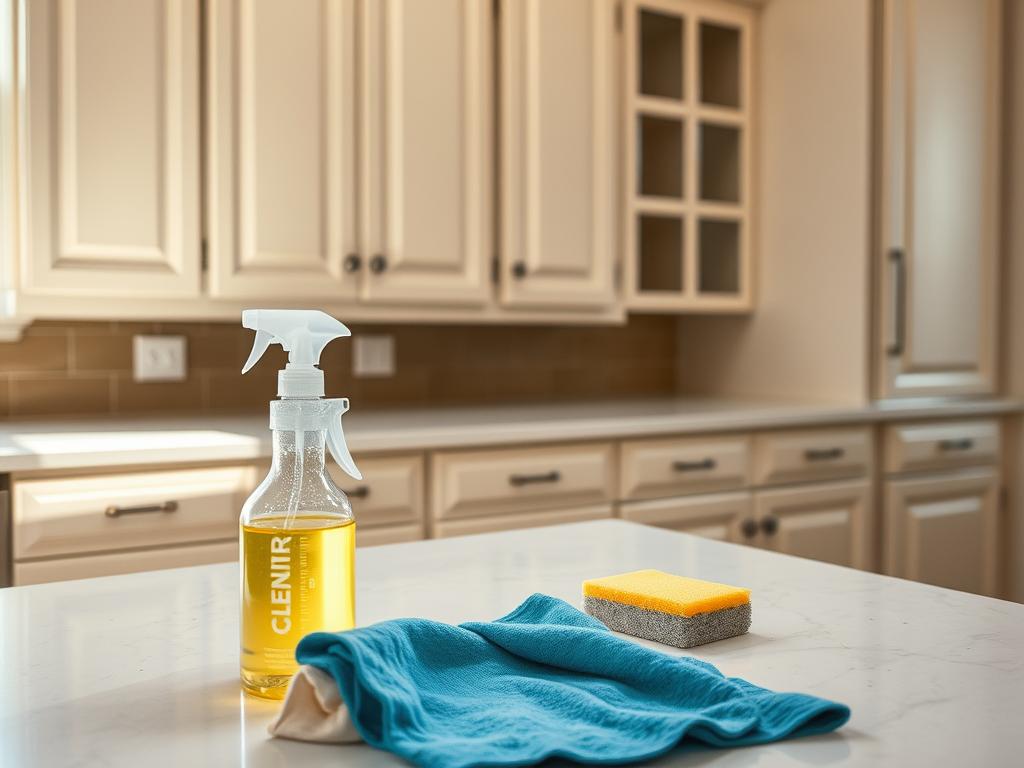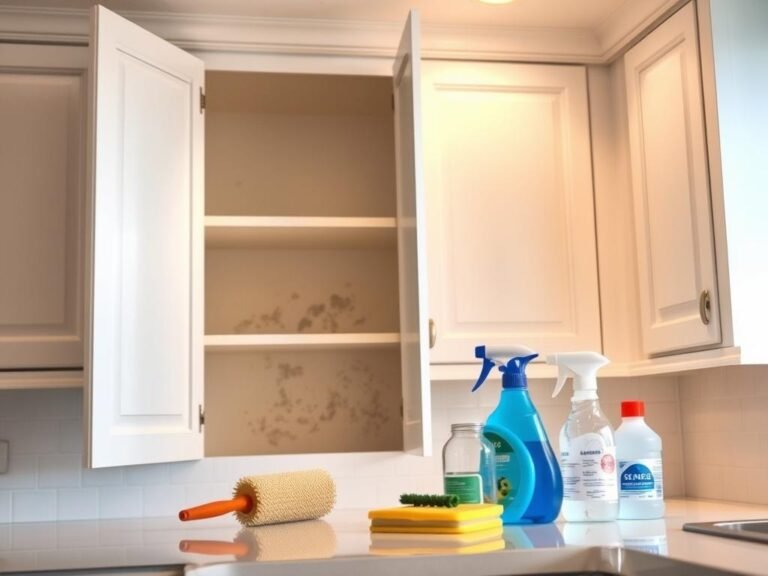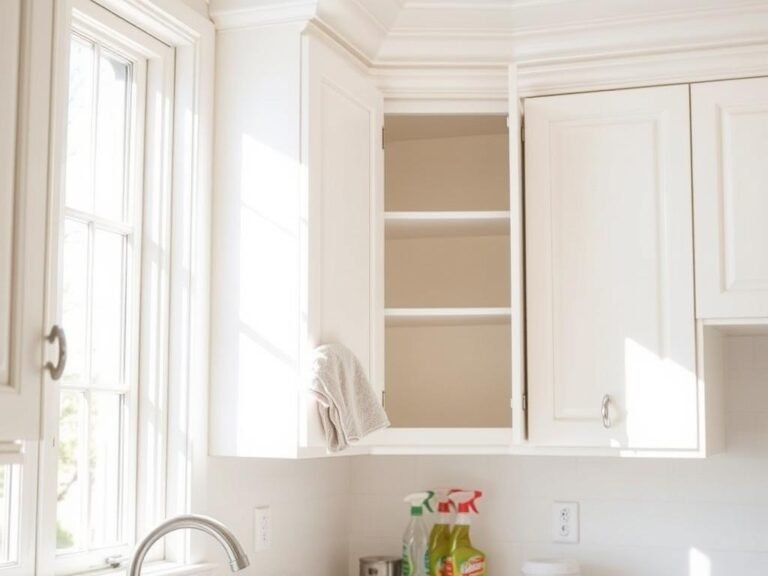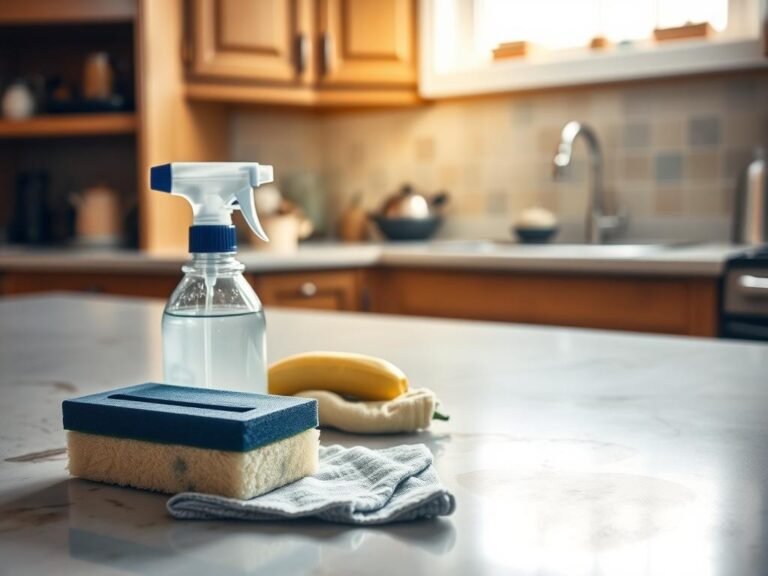Ever wondered why your painted kitchen cabinets lose their shine so quickly? The answer might surprise you. Many people unknowingly use harsh methods that damage the finish, leaving their kitchen looking dull and worn. The good news? With the right approach, you can keep your cabinets looking fresh and vibrant for years.
Regular care is essential to preserve the beauty of your painted kitchen. Weekly wiping with a microfiber cloth helps remove dust and prevent buildup1. For tougher spots, a gentle mix of dish soap and water works wonders without stripping the paint2. Avoid abrasive tools or harsh chemicals, as they can cause irreversible damage.
By following these simple steps, you can ensure your kitchen cabinets stay in top condition. Ready to learn more? Let’s dive into the best practices for maintaining your painted cabinet surfaces.
Key Takeaways
- Weekly cleaning prevents dust buildup and maintains shine.
- Use a microfiber cloth for gentle, effective cleaning.
- A mix of dish soap and water is safe for painted surfaces.
- Avoid abrasive tools and harsh chemicals to protect the finish.
- Regular care keeps cabinets looking new for years.
Understanding Your Painted Kitchen Cabinets
Not all cabinets are created equal, especially when it comes to their finish. Painted surfaces have unique characteristics that set them apart from traditional wood options. Knowing these differences helps you care for them properly and keep them looking their best.
What Makes Them Unique?
Painted cabinets offer a sleek, modern look that can transform any space. Unlike wood, they rely on a high-quality, KCMA-rated paint for durability and aesthetic appeal. This type of finish is more resistant to wear and tear but requires specific care to maintain its shine3.
Using the wrong cleaning products can cause damage. For example, wood-specific cleaners or waxes are not suitable for painted surfaces. Instead, a gentle mix of warm water and dish soap is recommended for routine maintenance4.
Differences Between Painted and Wood Cabinets
Wood cabinets benefit from natural grains and textures, which can hide minor imperfections. Painted cabinets, on the other hand, show every scratch and stain more prominently. This makes proper cleaning and care even more critical3.
Here are some key differences to keep in mind:
- Cleaning Methods: Painted surfaces need gentle solutions, while wood can handle stronger products.
- Durability: High-quality paint provides a durable finish, but it’s more prone to visible damage.
- Maintenance: Regular wiping with a microfiber cloth helps prevent buildup on painted cabinets5.
Understanding these differences ensures you choose the right tools and products for your cabinets. This way, you can avoid unnecessary damage and keep your kitchen looking fresh and vibrant.
The Importance of Regular Maintenance
A well-maintained kitchen starts with consistent care for your cabinets. Regular upkeep not only keeps them looking great but also prevents costly repairs down the line. By sticking to a routine, you can avoid common issues like stains, moisture damage, and wear6.
Benefits of a Routine Cleaning Schedule
Setting a cleaning schedule is a proactive way to protect your cabinets. Weekly wiping with a microfiber cloth removes dust and prevents buildup7. This simple step keeps your kitchen hygienic and reduces the risk of bacteria growth.
For tougher spots, a mix of dish soap and water works wonders. It’s gentle enough to preserve the paint while effectively removing grime8. Avoid harsh chemicals, as they can strip the finish and cause long-term damage6.
Periodic deep cleaning is also essential. Using solutions like baking soda can tackle stubborn stains without harming the surface8. This approach ensures your cabinets stay fresh and vibrant for years.
Adhering to a routine saves you time and effort. It also minimizes the need for extensive repairs or repainting7. By taking these small steps, you can enjoy a beautiful and functional kitchen every day.
how to clean painted kitchen cabinets
Maintaining the beauty of your cabinets doesn’t have to be a chore. With a few simple steps, you can keep them looking fresh and vibrant. The key is to establish a safe routine that avoids harsh methods and focuses on gentle care9.
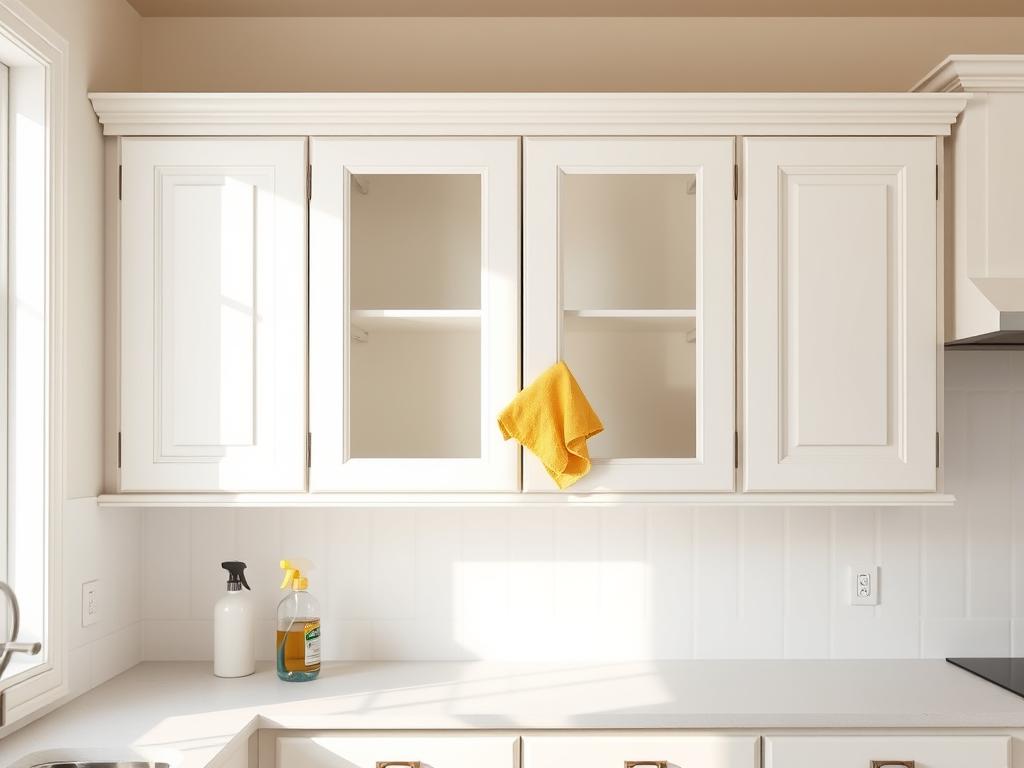
Setting Up a Safe Cleaning Routine
Start by wiping the outside of your cabinets weekly with a microfiber cloth. This prevents dust buildup and keeps the surface smooth9. For tougher spots, a mix of warm water and mild dish soap works well without harming the finish10.
Deep cleaning every few months ensures the inside stays spotless. Use a handheld vacuum to remove crumbs and debris9. Always test any cleaning solution on a small, hidden area before applying it widely10.
Quick Solutions for Daily Spills
Accidents happen, but quick action can prevent stains. For grease marks, a mix of two parts baking soda and one part warm water is effective9. Gently wipe the area with a soft cloth to avoid scratching the surface10.
Minimize water exposure to protect the finish. Use a damp cloth instead of soaking the surface10. This prevents swelling or splitting, especially around hinges and hardware9.
| Task | Recommended Solution | Frequency |
|---|---|---|
| Weekly Wiping | Microfiber cloth | Once a week |
| Deep Cleaning | Handheld vacuum, mild solution | Every few months |
| Spill Cleanup | Baking soda and warm water | As needed |
By following these steps, you can protect your cabinets from damage and keep them looking their best. A little care goes a long way in preserving their beauty9.
Daily Cleaning Essentials: Tools and Techniques
Keeping your cabinets in top shape requires the right tools and techniques. Daily care prevents dust and grime from building up, ensuring they stay fresh and functional11. With a few simple steps, you can maintain their beauty and extend their lifespan.

Using Warm Water and Dish Soap
A mix of warm water and a few drops of dish soap is a safe and effective solution for daily cleaning. This gentle combination removes grease and dirt without harming the finish12. Always use a damp cloth, avoiding excess water that could damage the surface.
For tougher spots, a homemade cleaner with baking soda and vinegar works wonders. It’s non-toxic and gentle on painted surfaces, making it a great alternative to harsh chemicals11.
Selecting the Right Microfiber Cloth
Choosing the right microfiber cloth is crucial. Soft and non-abrasive, it prevents scratches and ensures a streak-free finish12. Wipe down your cabinets weekly to remove dust and prevent buildup11.
Immediate cleanup of spills is also essential. A quick wipe with a damp cloth can prevent water spots and stains, keeping your cabinets looking pristine11.
By using these simple tools and techniques, you can maintain the aesthetic and functionality of your cabinets. A little effort goes a long way in preserving their beauty and durability.
Deep Cleaning and Stain Removal Strategies
Stubborn stains and grease don’t stand a chance with the right approach. Deep cleaning your kitchen cabinet surfaces ensures they stay fresh and functional. With a few simple steps, you can tackle tough spots without compromising the finish13.
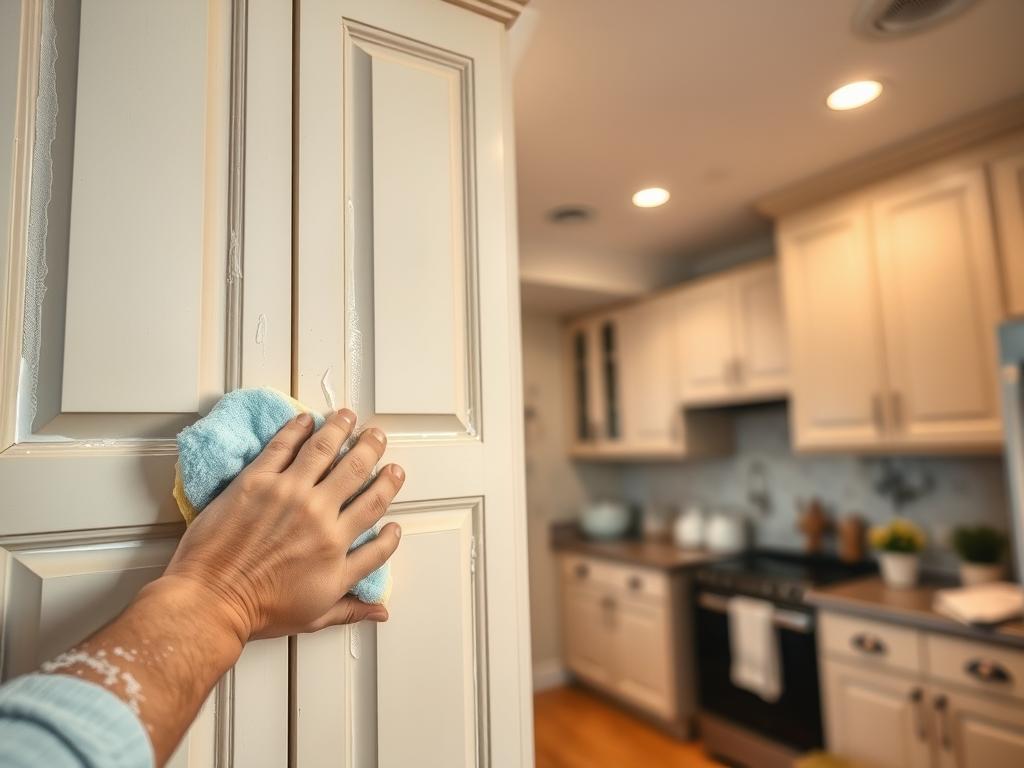
Mixing Gentle Cleaning Solutions
Start by creating a safe and effective cleaning solution. A mix of warm water and distilled vinegar (50/50 ratio) works wonders for removing fingerprints and light stains13. For tougher spots, combine one part water with two parts baking soda to form a paste14.
Always test the solution on a small, hidden area first. This ensures it won’t harm the paint or finish15. Use a soft microfiber cloth to apply the mixture gently, avoiding abrasive tools that could cause damage13.
Addressing Grease and Build-Up Effectively
Grease build-up is a common issue in the kitchen. Diluted vinegar is an excellent choice for breaking down grease without harsh chemicals13. Apply it multiple times if necessary, and always rinse with a damp cloth to prevent residue14.
For spills, act quickly to avoid stains. A mix of baking soda and water can lift fresh spills before they set13. Regular deep cleaning, recommended 3 to 4 times a year, keeps your cabinets looking their best13.
By using these strategies, you can maintain the beauty of your painted kitchen surfaces. A little care goes a long way in preserving their shine and durability.
Preventing Damage: What to Avoid
Protecting your cabinets from damage starts with knowing what to avoid. Harsh chemicals and abrasive tools can strip the finish and cause long-term harm. By steering clear of these pitfalls, you can keep your kitchen cabinet surfaces looking their best16.
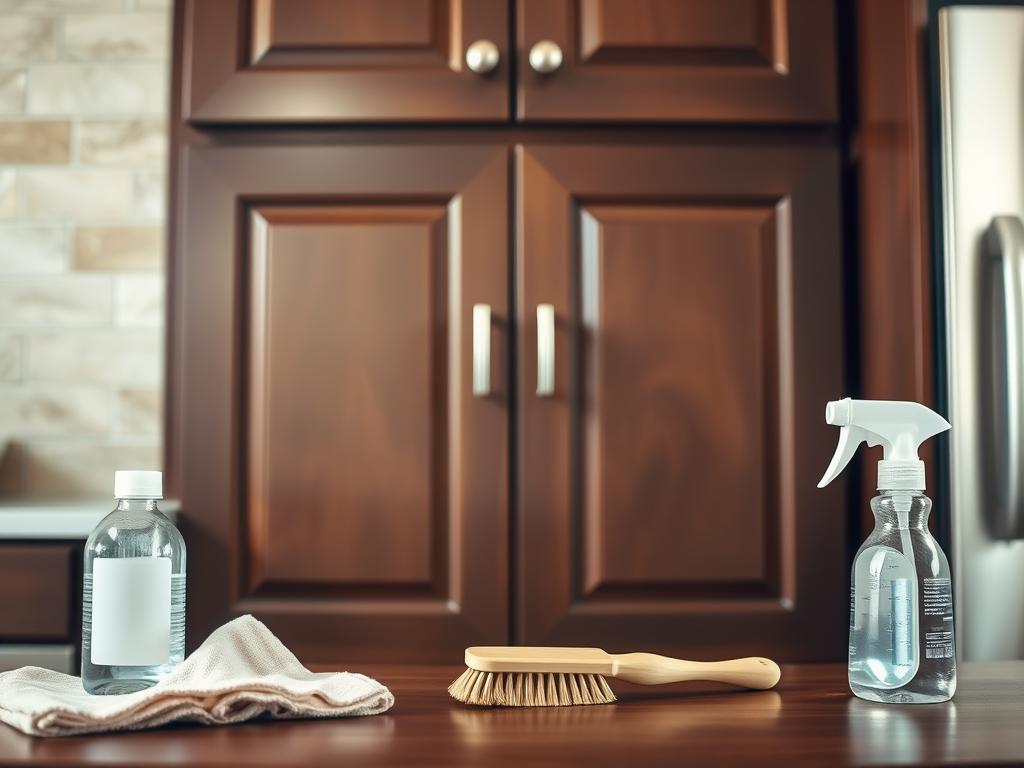
Steer Clear of Harsh Chemical Cleaners
Strong cleaners like bleach or ammonia can erode the paint and damage the surface17. Instead, opt for mild solutions like dish soap and water. These are gentle yet effective for routine cleaning18.
Avoid magic erasers or citrus-based formulas. These act like sandpaper, removing the sheen and leaving scratches16. Always test any new product on a small, hidden area before full application17.
Proper Care Around Hardware and Handles
Handles and hinges are prone to wear and tear. Use a soft cloth to wipe around these areas, avoiding abrasive tools that can scratch the finish16. Regular maintenance prevents buildup and keeps hardware functioning smoothly18.
Minimize moisture exposure near handles. Wipe spills immediately to prevent water damage, which can warp the material17. A dry towel after cleaning ensures no residue is left behind18.
Here are some quick do’s and don’ts for protecting your painted kitchen surfaces:
- Do use mild cleaners like baking soda and vinegar for tough stains17.
- Don’t use abrasive scrubbers or harsh chemicals16.
- Do wipe spills immediately to prevent staining18.
- Don’t soak surfaces in water, as it can cause swelling17.
By following these tips, you can keep looking your cabinets fresh and avoid costly repairs. A little care goes a long way in preserving their beauty16.
Expert Tips for Long-Term Cabinet Care
Proper care today can prevent costly repairs tomorrow. With a few expert strategies, you can keep your kitchen cabinet surfaces looking fresh and functional for years. Regular inspections and environmental management are key to preserving their beauty19.
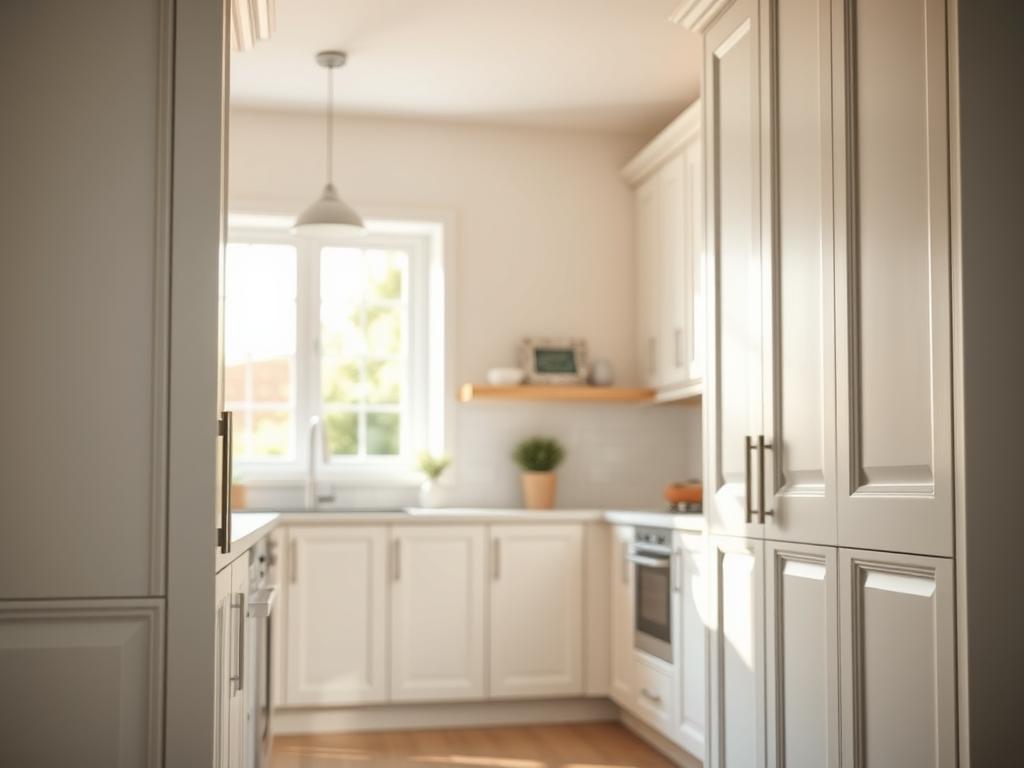
Regular Inspections and Maintenance
Schedule routine checks to catch issues early. Look for signs of damage, such as cracks, peeling paint, or moisture buildup19. Addressing these problems quickly prevents them from worsening.
Use a gentle solution of warm water and mild dish soap for weekly wiping. This removes dust and prevents grease buildup without harming the finish20. Avoid harsh products that can strip the paint or cause long-term damage19.
Managing Temperature and Humidity
Maintain a stable environment to protect your painted kitchen surfaces. Experts recommend keeping the temperature around 70°F and humidity levels between 40-50%19. This prevents warping, cracking, and other issues caused by extreme conditions.
Keep your cabinets away from direct heat sources or sunlight. Use fans or open windows to promote airflow and reduce moisture buildup19. These small adjustments can make a big difference in preserving your kitchen’s appearance.
| Task | Recommended Action | Frequency |
|---|---|---|
| Inspect Surfaces | Check for cracks or stains | Monthly |
| Wipe Down | Use warm water and dish soap | Weekly |
| Monitor Environment | Maintain 70°F and 40-50% humidity | Ongoing |
By following these expert tips, you can keep looking your painted kitchen surfaces in top condition. For early signs of wear or damage, consult a professional to ensure proper care19.
Conclusion
Consistent care ensures your cabinets remain a focal point of your home. By following simple steps like weekly wiping with a microfiber cloth and using gentle solutions, you can maintain their beauty21. Avoid harsh chemicals to protect the finish and extend their lifespan22.
Regular maintenance, such as deep cleaning every few months, prevents buildup and keeps surfaces spotless23. For tough spots, a mix of baking soda and water works wonders without causing damage21.
Integrate these easy steps into your routine to keep your kitchen looking fresh. For more tips, explore our blog or reach out for professional advice. With consistent care, your cabinets will stay vibrant and functional for years to come.

